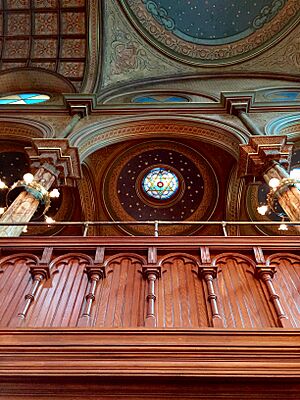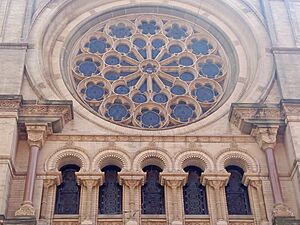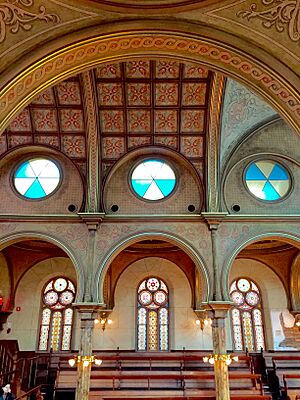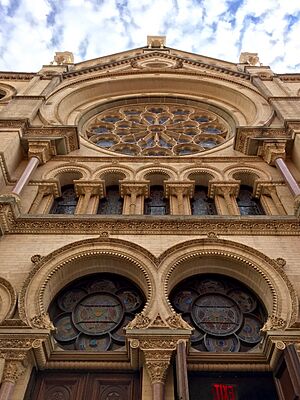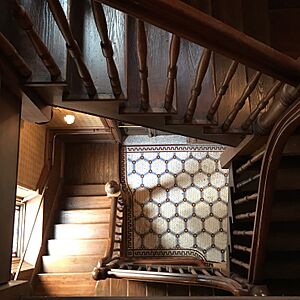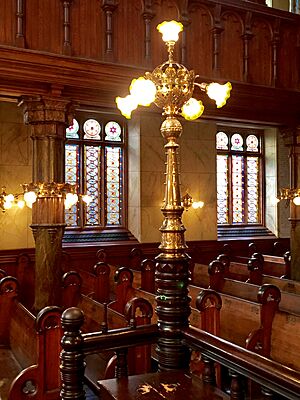Eldridge Street Synagogue facts for kids
The Eldridge Street Synagogue is a historic Jewish house of worship located in New York City. It was built in 1887 for a group of Jewish immigrants from Eastern Europe called Congregation Kahal Adath Jeshurun. This synagogue was one of the first in the United States built by Eastern European Jews. Today, the congregation, now known as Kahal Adath Jeshurun with Anshe Lubz, still holds weekly services there. The building is also home to the Museum at Eldridge Street, which opened in 1986. The synagogue is recognized as a very important historical site, both nationally and within New York City.
Quick facts for kids Eldridge Street Synagogue |
|
|---|---|

West facade in 2022
|
|
| Religion | |
| Affiliation | Orthodox Judaism |
| Ecclesiastical or organizational status | Synagogue |
| Ownership | Kahal Adath Jeshurun with Anshe Lubz |
| Status | Active |
| Location | |
| Location | 12 Eldridge Street |
| Municipality | Manhattan, New York City |
| State | New York |
| Country | United States |
| Architecture | |
| Architect(s) |
|
| Architectural type | Moorish Revival |
| Date established | 1852 (congregation) |
| Groundbreaking | September 1886 |
| Completed | September 4, 1887 |
| Construction cost | $91,907.61 (equivalent to $2,993,000 in 2022) |
| Specifications | |
| Direction of façade | West (main facade) |
| Length | 79 ft (24 m) |
| Width | 53 ft (16 m) |
| Site area | 60 by 87.5 ft (18.3 by 26.7 m) |
| Materials | Brick, terracotta |
The congregation started in 1852 as Beth Hamedrash. Its members came from many different parts of Eastern Europe. After moving several times, the group merged with another congregation in 1886 and became Kahal Adath Jeshurun. They wanted to build a large, beautiful synagogue to show their strong faith and attract new immigrants.
The synagogue was designed by Peter and Francis William Herter, two brothers who were not Jewish. They had never designed a synagogue before. The building was finished on September 4, 1887, and cost a lot of money for that time. Its opening was a big event, and many people came to see it.
Contents
Congregation's Journey
Early Years and Growth
The Eldridge Street Synagogue was very popular between 1890 and 1915. It had up to 800 families as members. People from all over Eastern Europe joined, making it different from other synagogues that focused on specific regions. The synagogue was a busy place, even allowing homeless people to stay during Passover. It was also where the Union of Orthodox Jewish Congregations of America was founded in 1896.
The synagogue had a cantor, Pinchas Minkowsky, who was very famous for his singing. He was paid a high salary to come from Odesa. The congregation's leaders, often wealthy businessmen, had a lot of power. They managed fundraising, hiring, and even educational programs. Women were not formal leaders until 1919, when a ladies' auxiliary group was formed.
Members paid fees for their seats, which could be bought or rented. The most expensive seats were at the front, but poorer members could pay less or even nothing. This allowed many people to be part of the community.
Rules and Traditions
The synagogue followed strict Orthodox Jewish rules. Services were held in Hebrew, and men and women sat separately. Women sat on the balcony, while men sat on the main floor. The leaders tried to keep order by banning spitting and loud talking, even hiring ushers to fine people. Despite this, arguments sometimes happened.
The synagogue also helped local Jewish schools and hosted study groups. It was a center for learning and community activities.
Challenges and Decline
After the 1920s, the number of members started to shrink. Many wealthy members moved to other parts of the city. Also, new immigration laws in 1924 limited how many new Jewish immigrants could come to the U.S. The main prayer hall was used less and less, and by 1954, it was completely closed. The remaining members held services in a smaller room in the basement.
The main sanctuary fell into disrepair. The roof had holes, pigeons flew inside, and parts of the building were damaged by water. Despite this, many original decorations remained, just covered in dust and dirt.
Saving the Synagogue
In the 1970s, people started to notice the synagogue's historical importance. A man named Gerard Wolfe began giving tours of the decaying building. Preservationists worked to get the synagogue recognized as a New York City landmark and added to the National Register of Historic Places in 1980. This helped protect the building.
Starting the Restoration
In 1978, a group called Friends of the Eldridge Street Synagogue was formed to raise money for repairs. They received grants and donations, and even the electric company forgave old unpaid bills. The roof was repaired in 1984, and the building was rededicated. The group also wanted to open a museum there.
By the mid-1980s, most Jewish people had moved out of the neighborhood, which was now mostly Chinese and Hispanic. The congregation was very small, sometimes struggling to find ten men for a minyan (the minimum number of adults needed for a public prayer service).
The Eldridge Street Project
In 1986, the Eldridge Street Project was created to fully restore the synagogue and create a museum. They leased the building for 99 years. The project aimed to raise millions of dollars for the restoration. Work began in 1989, with the goal of bringing the beautiful building back to life.
Throughout the 1990s, the restoration continued slowly due to funding challenges. However, the project still offered tours and programs, attracting thousands of visitors each year. In 1994, the main sanctuary hosted its first bar mitzvah in 40 years, showing signs of renewed life. The new roof was finished in 1999, allowing interior work to move forward.
By 2005, the project had raised $8 million. Workers cleaned, repainted, and repaired the interior. The beautiful finials (decorative tops) on the roof were reinstalled in 2006, and the stained glass window above the main entrance was restored in 2007. Many people and organizations donated to the project, including the New York City government.
The Synagogue Today
On December 2, 2007, the synagogue was rededicated after its $20 million renovation. The Eldridge Street Project was renamed the Museum at Eldridge Street. Today, the building serves as both a museum and a place of worship.
The Museum
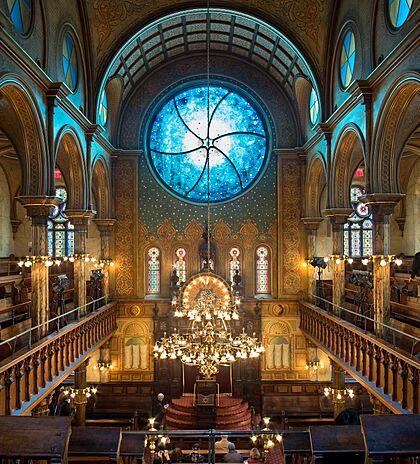
Museum interior in 2018
|
|
| Established | 1986 (Eldridge Street Project) December 2, 2007 (gallery space) |
|---|---|
| Type | Jewish museum |
| Collections | American Jewish history |
The Museum at Eldridge Street is a nonprofit organization. As of 2022, it had a revenue of $1.56 million. The museum offers exhibits and activities about the congregation's history, the local community, and Jewish culture. It has interactive displays and artifacts.
The museum also hosts many events, including concerts, lectures, and tours. One popular event is the "Egg Rolls, Egg Creams and Empanadas" festival, which celebrates the neighborhood's diverse cultures. The museum also has programs for children, where they can explore the synagogue.
The Congregation
A small number of worshippers still hold services at the synagogue. The congregation, Kahal Adath Jeshurun with Anshe Lubz, has almost never missed a service since the synagogue opened. They hold Hebrew-language Shabbat services on Fridays and Saturdays in the basement spaces. The main sanctuary is primarily used by the museum.
Famous people who were once members or worshipped here include entertainers like Eddie Cantor and Edward G. Robinson, and scientists like Jonas Salk.
Building Design
The synagogue is located on Eldridge Street and is about 60 by 87.5 feet in size. It was designed to stand out from the surrounding apartment buildings. The building's style is called Moorish Revival, with touches of Gothic Revival and Romanesque Revival styles. The architects, Peter and Francis William Herter, used many decorative elements like horseshoe arches and Stars of David.
Outside the Synagogue
The front of the synagogue faces west. It is made of brown brick with terracotta decorations. The design includes three vertical sections, with two square towers on the sides. The number of windows and doors often matches important numbers in Judaism, like 3 (for the three patriarchs) or 12 (for the Twelve Tribes of Israel).
There are three stairways leading to the main entrance. The center stairway was for men, and the outer ones were for women. The doors are made of wood and have carved Stars of David. Above the doorways are horseshoe arches.
On the third story, there is a large rose window in the center, similar to those found in Gothic churches. This window originally had a Star of David and roundels showing the Twelve Tribes of Israel. The roof once had decorative finials and cresting, which were removed in 1960 but restored in 2006.
The back of the synagogue also has a large rose window, which was replaced in 2010. This new window, designed by Kiki Smith and Deborah Gans, features yellow and blue glass with both six-pointed Stars of David and five-pointed stars, mixing Jewish and American symbols.
Inside the Synagogue
The main prayer hall, or sanctuary, is a very large space that goes up three stories. Following Orthodox Jewish tradition, the back of the synagogue faces east toward Jerusalem. Men and women had separate seating areas and entrances. The lights were originally gas-powered but were later changed to electric.
The sanctuary has tall wooden columns that look like marble. These columns support the second-story balcony. The ceiling above the center section is very high, about 70 feet tall, with a large dome. The floor is made of wood and has grooves from years of worshippers moving back and forth during prayer.
At the eastern end of the main level is the Torah ark, which holds the Torah scrolls. It is beautifully carved and lit by many lightbulbs. In the center of the main level is a raised platform called a bimah, where the Torah is read.
A three-sided balcony runs along the western, northern, and southern walls. This was originally where women sat. Today, it is an exhibition space for the museum. The balcony's design allowed men and women to see each other, which was different from older synagogues.
The sanctuary is lit by many brass lighting fixtures, including a large chandelier. The walls and ceilings are richly decorated with abstract and geometric patterns, including gold stars on a blue background. There are no pictures of people or animals, as this is avoided in Orthodox tradition.
The lower level of the synagogue was originally a study hall, called the beth midrash. This is where the congregation met after the main sanctuary closed. Today, this area is part of the museum and includes a history center with recordings of synagogue members and exhibits about the neighborhood.
Impact and Recognition
How People Saw It
When the synagogue was first built, people praised its unique design and how it stood out. Some Jewish leaders believed its beauty would encourage people to stay with Orthodox Judaism. Others thought the money might have been better spent on education.
After the restoration, many people were amazed by the synagogue's beauty. Writers described it as "almost hallucinatory in its luminosity" and "awestruck by the exotic splendor." Its dual use as a museum and a place of worship is seen as a sign of modern times. As of 2025, Time Out magazine even called it one of the world's most beautiful buildings.
Its Importance
The Eldridge Street Synagogue is important because it shows the presence of Eastern European Jews in the United States. It was one of the first large American synagogues built specifically for Orthodox Jews. Its design also influenced other synagogues built in the area.
Landmark Status
The Eldridge Street Synagogue was added to the National Register of Historic Places in 1980 and became a New York City landmark that same year. In 1996, it was designated a National Historic Landmark (NHL), which is a very high honor. It is one of only four synagogues in the United States with this special designation as of 2025.
In Media
The synagogue has appeared in many books and films. It was featured in a 1998 Hanukkah book and used as a filming location for the TV series Hunters in 2020. The writer Pete Hamill was inspired by the synagogue for his 1997 novel Snow in August. A short film called A Great Day on Eldridge Street was made for its 120th anniversary. The synagogue's history and restoration have also been detailed in several books.
See also
 In Spanish: Sinagoga de la Calle Eldridge para niños
In Spanish: Sinagoga de la Calle Eldridge para niños





